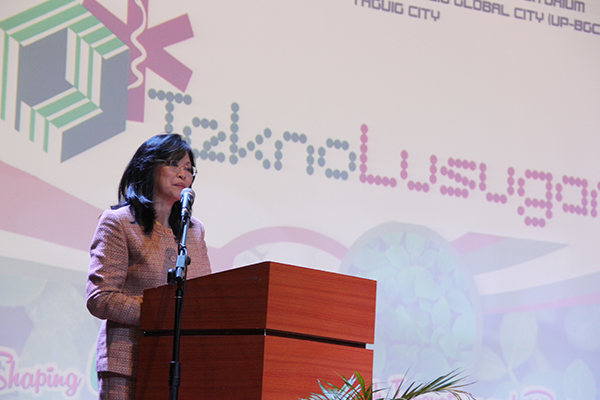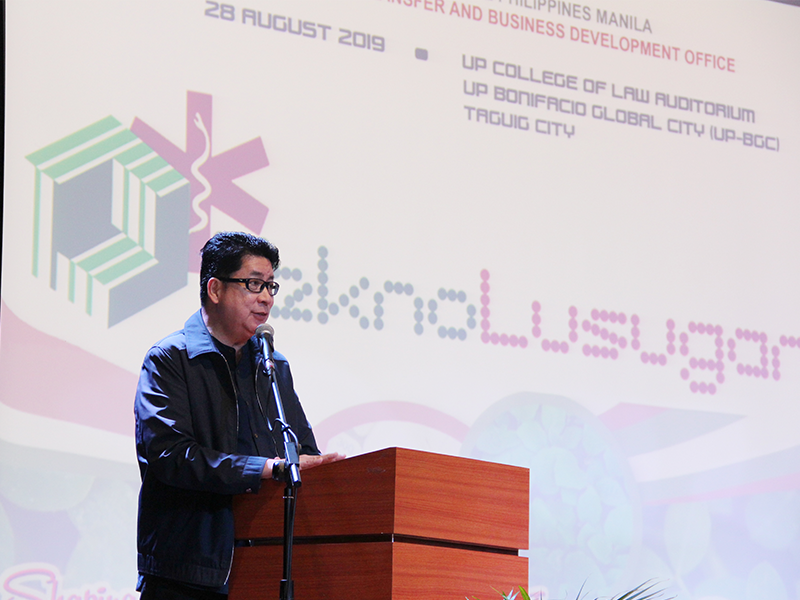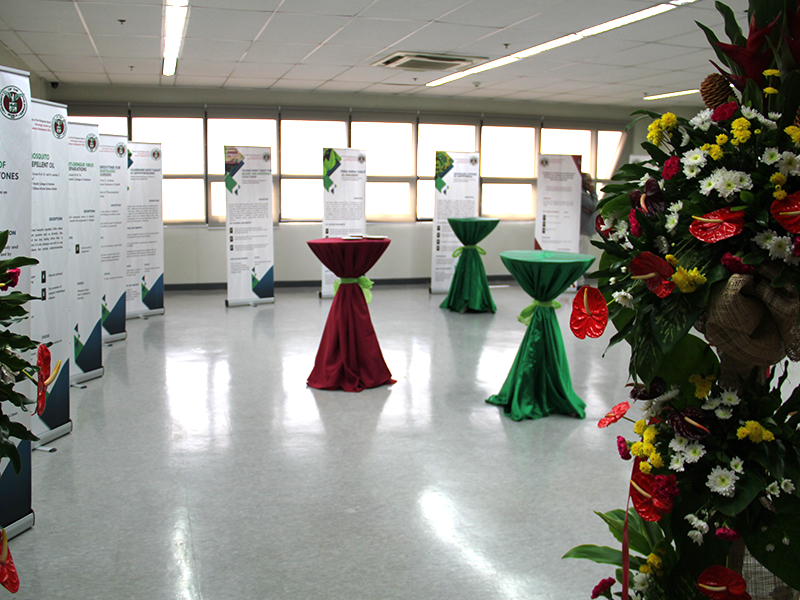From Yerba Buena for post-operative pain control to a mobile application for hip fracture detection, UP Manila has inventions and innovations in health which can benefit Filipinos. But its researchers and innovators need industry partners to progress—ranging from further research to development to licensing to expansion. To help the group, a one-day event was held where industry and government agencies were invited to listen to the scientists pitch their work.
Called “TEKNOLUSUGAN: Shaping UP Juan’s Health Through Innovations and Partnerships”, it was held on 28 August 2019 at the University of the Philippines-Bonifacio Global City (Henry Sy Jr Hall, University Parkway, BGC). The activity was part of the UP Manila Science and Technology Week from 27-30 August 2019.
Organized by the UP Manila Technology Transfer & Business Development Office (UPM-TTBDO) under the aegis of the Office of the Vice Chancellor for Research (OVCR), seven medicinal plant products and six biomedical devices and innovations were pitched to guests from the industry and government agencies.

Chancellor Carmencita Padilla described the event as the “the start of a series of conversations with industry…The researches of the faculty and researchers will be no good if they do not move on to policy or industry.”
She apprised the audience that part of what UP Manila does in this area is to dialogue with the Department of Health (DOH) to ensure that the government will be open to adopt a product once it is finished and its clinical trials completed.
For universities which have several ideas in research, but lack the numbers for clinical trials, the chancellor assured them that UPM and PGH are willing to help. “Any progress in health research will mean much for the country,” she said.

Dr. Jaime Montoya, Executive Director of the DOST’s Philippine Council for Health Research & Development (PCHRD) and the government official described by Chancellor Padilla as the reason why research in the country is moving forward, gave an update of what his agency offers researchers with regard to the product development cycle–from Proof of Concept to Market (whether industry or community-at-large). He mentioned the following: Grants-in-Aid for research projects; Prototype Development; and, Technology Transfer Offices (from policy orientation to capacity-building). Other things Dir. Montoya mentioned will have a big impact on research: creation of the Health and Technology Assessment Council (HTAC) which will advise government which technologies it could acquire (this could be placed under the PCHRD); a proposal for UP Manila to establish a Clinical Trial Center under the PCHRD’s NICHE Center for Excellence Program; and, a proposal for the establishment of a Government Pharmaceutical Organization (GPO) which will support Philippine health technologies for Filipinos. Thailand has a GPO and it was able to bring down the prices of anti-retroviral drugs which, in turn, lowered significantly the country’s HIV cases. He finished his speech by thanking everyone for the work they have been doing.

Since August 28 was also the day the UP Board of Regents approved into law the creation of UPM-TTBDO, past heads of the unit were invited to be honored. They were Atty. Zaldy Docena (1 Feb. 2006 – 21 Feb. 2010), now a Regional Trial Court Judge, under whose term as Chief Legal Counsel of the UP Manila Legal Office, the Intellectual Property Office (IPO) was conceptualized. He penned the document which went to the UP BOR for approval. Following him were Atty. Elizabeth Pulumbarit (22 Feb.-21 Oct. 2011), who put together the TTBDO at the UP System level; the late Atty. Anunciacion Ayo as Officer-in-Charge of IPO (11 Nov. 2011-31 Dec. 2013), her nieces Frances and Diane Barcena received the plaque for her; Atty. James Dennis Gumpal as IPO’s OIC (1 Apr. 2014-30 June 2015); and, Dr. Alvin Valeriano Marcelo also as IPO’s OIC (1 July-24 Aug. 2015), then Director of UPM-TTBDO (25 Aug. 2015-31 Dec. 2018). He was represented by his children, Andres Artemio and Athena Andrea Marcelo. Dr. Lourdes Marie Tejero is the current head of the unit.
The medicinal plant products presented all had rare to no side effects, made from locally-sourced materials (hence, will benefit farmers), cheaper than the synthetic ones in the market, and will boost the Philippine Pharmaceutical Industry.
These products were: Yerba Buena tablets for relief of various types of pain, including post-operative ones, Tsaang Gubat tablets for pain from gastrointestinal colic and biliary colic pain, Ulasimang Bato or pansit-pansitan for the treatment of hyperuricemia and gout, Sambong as a diuretic and for treating urinary tract stones; Anti-Dengue Virus Preparations for the treatment and prevention of dengue disease and outbreak; Mosquito Repellent Oil that is highly potent yet non-toxic, cheaper, and longer-lasting than leading brand; and, Hemoxyther for iron deficiency anemia.1
The biomedical devices and innovations presented were DEFA1 and CFI Marker (diagnostic and decision-making tool kits for the prevention of occurrences of leptospirosis-related death and complications through medical intervention); Community Health Information Tracking System (CHITS), a proven efficient electronic medical records (EMR) for patients’ record management, reports generation, claims processing; PEPTHEMATICS—Peptides and Modified Blood Products for Diagnosis and Treatment of Coagulopathic, Inflammatory, and Infectious Conditions; Battle in the Blood (BitB) is an HIV digital advocacy gaming application currently available for free on Google Play and App Store; AcquilaVR is a virtual reality (VR) application which complements existing autism therapies to help lessen the unpredictable behavior of school children with Autism Spectrum Disorder; and, COXA or Deep Learning for Hip Fracture Classification, a mobile application for hip fracture which can be used in areas without internet or a temporarily absent radiologist, with teleconsultation functionalities.2
The open forum held after each set of presentation dealt with queries regarding the products presented as well as other innovations/inventions from UP Manila. Chancellor Padilla revealed that UP Manila has 60 other inventions/innovations in the pipeline. These do not include the biomedical devices from its training institution, the Philippine General Hospital. She intimated that another event may be organized by the OVCR and UPM-TTBDO devoted solely to PGH products.
However, the highlight of the fora were the researchers’ interests on intellectual property rights and international licensing, especially on funding. Guests from the Department of Science & Technology (DOST) and the Intellectual Property Office of the Philippines (IPOPHL) gave succinct answers on what to do, especially on filing your patent early, but it was clear that the researchers in the audience were hungry for more in-depth discussions.
To inquire about intellectual property, innovation, and technology transfer in the campus, please visit the website of the UP Manila Technology Transfer & Business Development Office: website is http://ttbdo.upm.edu.ph/. Its contact info are Phone: (02) 3105731 / Telefax: (02) 3105727 / Email: ttbdo@post.upm.edu.ph. (FMJemena)